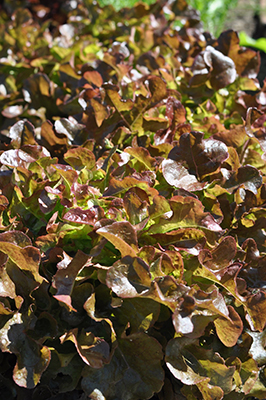Lactuca sativa L. var. foliosa Brehmer cv. Red Salad Bowl (Asteraceae)



| ENG | Bowl leaf lettuce |
| SK | Šalát listový bowl |
| CZ | Salát listový bowl |
| PL | Sałata liściowa bowl |
| HU |
Using
Red leaf lettuce has been shown to lower cholesterol absorption, provide exceptionally high amounts of antioxidants, and deliver plenty of provitamin A which is crucial for good eye health. Plant suitable to use in low-caloric diet.
| I. | II. | III. | IV. | V. | VI. | VII. | VIII. | IX. | X. | XI. | XII. | |||||||||||||
| Sowing | ||||||||||||||||||||||||
| Planting | ||||||||||||||||||||||||
| Harvest | ||||||||||||||||||||||||
Botanical description and occurrence:
Type of lettuce that grows in leaves and does not form a head. Rosettes are slightly concave inside. Its leaves are maroon-red, large, deeply lobed, crisp and tender with a sweet flavor. ‘Red Salad Bowl‘ belongs to a group of ’bowl‘ type of lettuces, it is a long-standing, slow-to-bolt and early maturing lettuce (full maturity after 50 days from transplanting), that grows well all season and leaves can be harvested over period of time. Mature plants weigh up to 300 g. The most intense color of the leaves can be observed when the temperature drops below 10°C for several days. Plants contain a lot of vitamin C, B1, B2, K, tocopherols, provitamin A, and phenolic compounds, especially anthocyanins.
Why to have the plant in your garden:
Beautiful, rosette plants, very decorative, can be used for salads (alone or as additional component), vegetable mixtures, as baby leave salad green, decorative component of dishes. The great advantage is the ability to harvest individual leaves during vegetation period.
Text:
Dr. Andrzej Kalisz, University of Agriculture in Krakow, Poland
Photo:
Dr. Ivana Mezeyova, Slovak University of Agriculture in Nitra, Slovak Republic

